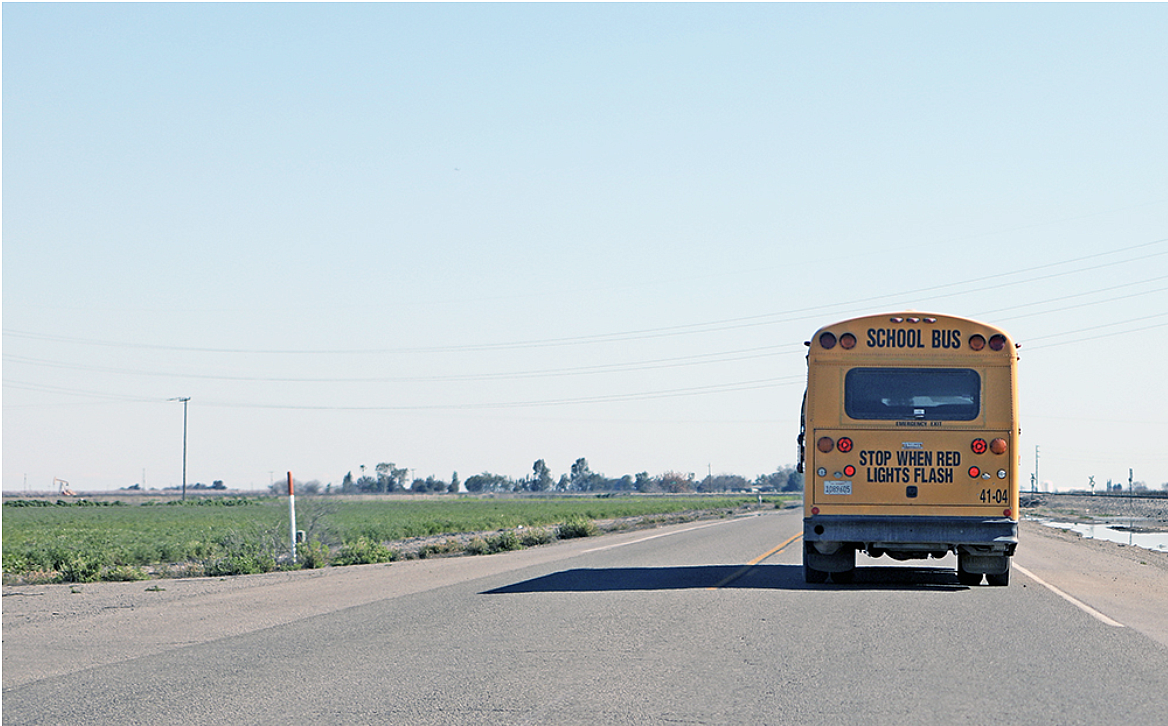Help EdSource shine a light on challenges in rural education
This story was produced as part of a larger project led by David Washburn, a participant in the USC Center for Health Journalism's 2018 Data Fellowship.
Other stories in this series include:
Lost Days: Poverty, isolation drive students away from school in California’s rural districts
Lost Days: Inside one rural California district's effort to combat chronic absenteeism
Rural California school district with high suspension rates under state investigation

A rural school bus heads out to a campus to pick up students.
(Photo Credit: Fermin Leal/EdSource Today)
There is nothing more fundamental to a student’s success in school than his or her ability to be there. Students who are chronically absent are likely to lag in every measure of achievement from grades to test scores to graduation rates and college readiness.
Only in recent years has the California Department of Education begun tracking chronic absenteeism statewide and the early data show a large divide between urban and rural districts. Schools with extreme absenteeism, defined as having 30 percent or more of their students chronically absent, are far more prevalent in rural California.
We at EdSource see it as our responsibility to shine a light on issues like this and search for solutions as part of our mission to cover all aspects of education throughout California. We want to tell the stories of teachers, students and their families who are overcoming challenges to educate the state’s next generation.
Among our priorities for 2019 is a series of stories on the challenges facing rural school districts in California. In addition to chronic absenteeism, we are interested in issues ranging from suspensions and school climate to state financial support, college access and career options and graduation rates.
Regarding absenteeism, California Department of Education data show tiny Golden Feather Union Elementary School District in Butte County had a chronic absenteeism rate of 50 percent during the 2017-18 school year — which means that half of its students were absent for at least 15 days during the school year. This compares to a rate of 12 percent for Los Angeles Unified.
Unfortunately, these numbers come as no surprise to those who live in rural areas or study rural education. Carl Cohn — a former superintendent of both Long Beach Unified and San Diego Unified, two of the largest urban school districts in the state — highlighted the task facing rural districts when he wrote in EdSource last year about a visit to Modoc County, which is tucked in the far northeast corner of the state. Cohn was visiting the county as the then-executive director of the California Collaborative for Educational Excellence, a state agency created to provide support to school districts to improve education outcomes.
“We heard about the opioid crisis, the fact that there are no eligible foster parents in the entire county, that five county mental health positions remain unfilled, that the hardest possible job to fill is that of a school bus driver and that a youngster needs to drive three-plus hours to find a community college in a state that is pushing college for all,” Cohn wrote in his EdSource commentary.
What Cohn discovered on the ground in Modoc is not the exception. The decline of industries in recent decades (in Modoc’s case the timber industry) that were once the lifeblood of rural communities, have created challenges in rural areas for teachers and administrators working to give students a quality education.
“Our trip to Modoc County was a great learning experience for someone like me, who has spent more than four decades working in large urban school districts,” Cohn wrote. “I used to buy the conventional wisdom that urban educators faced the biggest challenges in doing their jobs. I’m not so sure about that anymore.”
Other reporting and research back up Cohn’s observations. Experts say rural areas may face problems that are often described as typically urban, such as poverty, drug abuse and crime. Geographic isolation often adds to the challenges faced by educators working in these school districts where resources are often limited.
Support from the national Education Writers Association and the USC Annenberg Center for Health Journalism will allow EdSource to expand its data-driven research to help us uncover new truths regarding the underlying causes of chronic absenteeism and other rural education disparities. The funding will also support our efforts to send journalists into the field to report from the local communities.
But we can’t do it alone. California is a big place and we are a small newsroom. Most importantly, we need eyes and ears on the ground — students, parents, teachers, administrators and community members whose real experiences can help us make a difference.
And we need researchers, policymakers and advocates to weigh in with their insights. We’ve already reported on the newly formed California Rural Ed Network of rural educators, which launched on Oct. 1 to attract new resources, share expertise and shift the attention of policy makers to schools outside urban and suburban California — many of them underfunded and serving a preponderance of low-income students.
We urge you to tell us about your school, your community and your efforts to help students succeed.
We have set up a special email address — rural@edsource.org — that you can use to send us your insights, links to relevant research, contacts for sources and story tips. With your help, we can give this story the attention it deserves and make sure it gets to the people who have the power to make a difference.
[This story was originally published by EdSource.]

